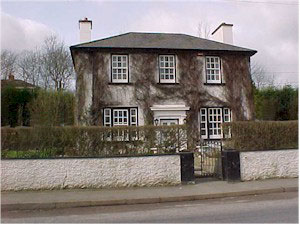
Interview
with Mr. Seamus Farrell on his memories of the Train
The house was built in 1917 and is one of the finer houses in the town at present. There was a private water supply in the house at that time which was very unusual and it was the only house in the town that had a bath. The winters were tough at that time and often the track became so slippery with ice and frost that they had to put sand on it for the train wheels to get a grip on the track.
About 100 yards up from the house was a store. All the supplies for the town came by train and were dropped off at that store. Cigarettes, Jam, Sprongs, Forks and Shovels were just some of the items that Mr. Farrell remembers being unloaded. Johnny Corcoran (who would have been the Great Grandfather of one of the boys in our school) was in charge of the store and he delivered the goods to the various places around the town. He often had two horses to deliver the supplies. Close to the store was an enormous water tank to supply the train with water for the steam. The train pulled in under the tank every day and got a fill up. As the train whistled along the track it was lovely to watch the large cloud of steam shooting out of it's chimney.
The first bit of land given away by C.I.E. after the train stopped running was where Mr. Farrellís garage now is and of course Mr. Farrell called his new garage "The Railway Garage". When the mines slowed down the minerís still used to bring goods to the store.
The Coalmining company were originally going to run the track as far as the Swan where there is a fire clay factory. This never happened. When they were building the line at Dysart bridge they had to erect two bridges to cross the Deen river and the Uskerty river. These bridges were very close to where the rivers met ("a comer") and had the engineers chosen a slightly different route for the track (about 400 yards) then one bridge would have done the job. However they would have had to cut in to a hill so the cost of building the bridges must have been less than cutting through the hill.
When the engineers had just erected the pillars for the bridges a big floods came and swept the whole yolk (local word for "everything") out of it so they had to rebuild it again and put it up much higher so that the water would not knock it down again.
The bridge has long since gone and is supposed to be in use in some other part of the country. Several attempts have been made to knock the pillars and concrete base but all efforts have failed and as such the relic of the train is still there.

Mr. Farrell joins us for a chat